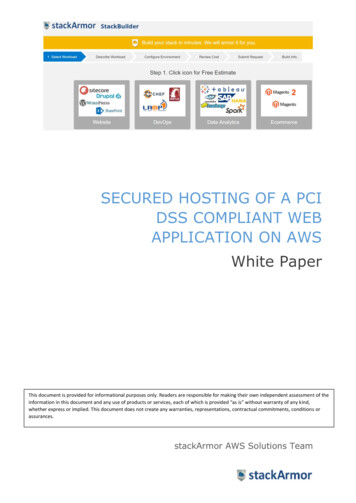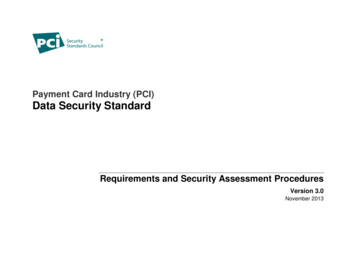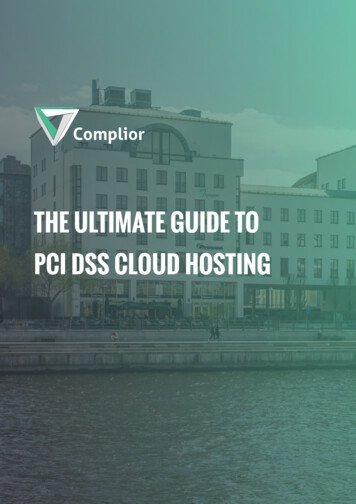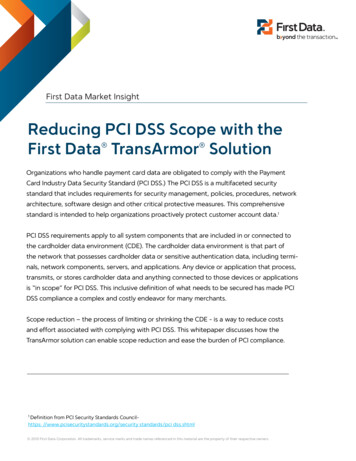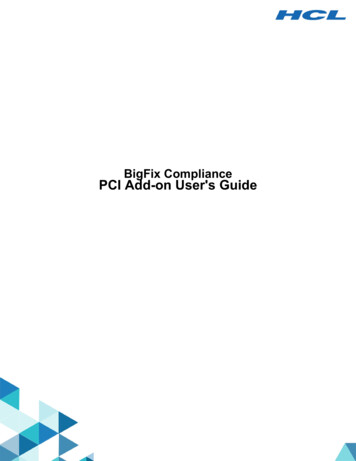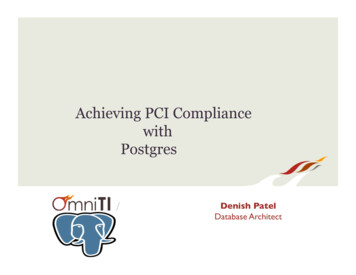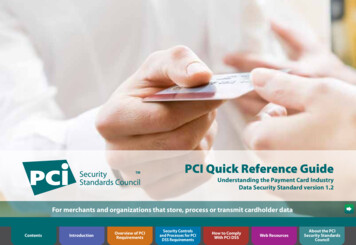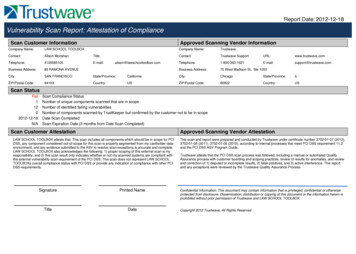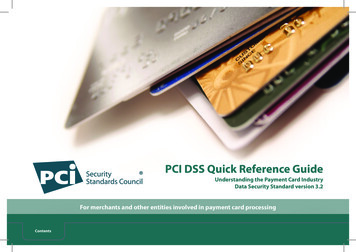
Transcription
PCI DSS Quick Reference GuideUnderstanding the Payment Card IndustryData Security Standard version 3.2For merchants and other entities involved in payment card processingContents
PCI DSS Quick Reference Guide: Understanding the Payment Card Industry Data Security Standard version 3.2.Copyright 2009-2016 PCI Security Standards Council, LLC. All Rights Reserved.This Quick Reference Guide to the PCI Data Security Standard (PCI DSS) is provided by the PCI Security StandardsCouncil (PCI SSC) to inform and educate merchants and other entities involved in payment card processing. For moreinformation about the PCI SSC and the standards we manage, please visit www.pcisecuritystandards.org.The intent of this document is to provide supplemental information, which does not replace or supersede PCI Standardsor their supporting documents.May 2016
ContentsIntroduction: Protecting Cardholder Data with PCI Security Standards . 4Overview of PCI Requirements. 6The PCI Data Security Standard .9Security Controls and Processes for PCI DSS Requirements. 11Build and Maintain a Secure Network and Systems. 12Protect Cardholder Data. 14Maintain a Vulnerability Management Program. 16Implement Strong Access Control Measures. 18Regularly Monitor and Test Networks. 21Maintain an Information Security Policy. 24Compensating Controls for PCI DSS Requirements. 26How to Comply with PCI DSS. 27Choosing a Qualified Security Assessor. 28Choosing an Approved Scanning Vendor. 29Scope of PCI DSS Requirements. 30Using the Self-Assessment Questionnaire. 33Reporting. 35Implementing PCI DSS into Business-as-Usual Processes. 36Web Resources. 37About the PCI Security Standards Council. 39This Guide provides supplemental information that does not replace or supersede PCI SSC Security Standards or their supporting documents.Introduction3
Introduction: Protecting Cardholder Data withPCI Security StandardsThe twentieth century U.S. criminal Willie Sutton was said to rob banks because “that’s where themoney is.” The same motivation in our digital age makes merchants the new target for financial fraud.Occasionally lax security by some merchants enables criminals to easily steal and use personal consumerfinancial information from payment card transactions and processing systems.It’s a serious problem – more than 898 million records with sensitive information have been breachedfrom 4,823 data breaches made public between January 2005 and April 2016, according to PrivacyRights.org. As you are a key participant in payment card transactions, it is imperative that you use standardsecurity procedures and technologies to thwart theft of cardholder data.Merchant-based vulnerabilities may appear almost anywhere in the card-processing ecosystemincluding: point-of-sale devices; mobile devices, personal computers or servers; wireless hotspots; web shopping applications; paper-based storage systems; the transmission of cardholder data to service providers; in remote access connections.Vulnerabilities may also extend to systems operated by service providers and acquirers, which are thefinancial institutions that initiate and maintain the relationships with merchants that accept paymentcards (see diagram on page 5).Compliance with the PCI DSS helps to alleviate these vulnerabilities and protect cardholder data.This Guide provides supplemental information that does not replace or supersede PCI SSC Security Standards or their supporting documents.4RISKY BEHAVIORA survey of businesses in the U.S.and Europe reveals activities thatmay put cardholder data at risk.81% store payment cardnumbers.73% store payment cardexpiration dates.71% store payment cardverification codes.57% store customer data on thepayment card magnetic strip.16% store other personal data.Source: Forrester Consulting: The State ofPCI Compliance (commissioned by RSA/EMC)
INTERNETPUBLIC NETWORKSWIRELESSPOSINTERNETPUBLIC NETWORKSWIRELESSMerchantINTERNETPUBLIC NETWORKSWIRELESSService ProviderAcquirerThe intent of this PCI DSS Quick Reference Guide is to help you understand how the PCI DSS can helpprotect your payment card transaction environment and how to apply it.There are three ongoing steps for adhering to the PCI DSS:Assess — identifying all locations of cardholder data, taking an inventory of your IT assets and businessprocesses for payment card processing and analyzing them for vulnerabilities that could exposecardholder data.PCI DSS COMPLIANCE IS ACONTINUOUS PROCESSASSESSRepair — fixing identified vulnerabilities, securely removing any unnecessary cardholder data storage,and implementing secure business processes.Report — documenting assessment and remediation details, and submitting compliance reports to theacquiring bank and card brands you do business with (or other requesting entity if you’re a service provider).REPAIRREPORTPCI DSS follows common-sense steps that mirror security best practices. The PCI DSS globally applies toall entities that store, process or transmit cardholder data and/or sensitive authentication data. PCI DSSand related security standards are administered by the PCI Security Standards Council, which was foundedby American Express, Discover Financial Services, JCB International, MasterCard Worldwide and Visa Inc.Participating Organizations include merchants, payment card issuing banks, processors, developers andother vendors.This Guide provides supplemental information that does not replace or supersede PCI SSC Security Standards or their supporting documents.Overview of PCIRequirements5
6Overview of PCI RequirementsPCI Security Standards are technical and operational requirements set by the PCI Security StandardsCouncil (PCI SSC) to protect cardholder data. The standards apply to all entities that store, process ortransmit cardholder data – with requirements for software developers and manufacturers of applicationsand devices used in those transactions. The Council is responsible for managing the security standards,while compliance with the PCI set of standards is enforced by the founding members of the Council:American Express, Discover Financial Services, JCB, MasterCard and Visa Inc.PAYMENT CARD INDUSTRY SECURITY STANDARDSProtection of Cardholder Payment DataManufacturersSoftwareDevelopersPCI PTSPCI PA-DSSPIN EntryDevicesPaymentApplicationsMerchants &Service ProvidersPCI DSSSecureEnvironmentsPCI Security& ComplianceP2PEEcosystem of payment devices, applications, infrastructure and usersThis Guide provides supplemental information that does not replace or supersede PCI SSC Security Standards or their supporting documents.
PCI Security Standards Include:PCI Data Security Standard (PCI DSS)The PCI DSS applies to all entities that store, process, and/or transmit cardholder data. It covers technicaland operational system components included in or connected to cardholder data. If you accept orprocess payment cards, PCI DSS applies to you.PIN Transaction Security (PTS) RequirementsThe PCI PTS is a set of security requirements focused on characteristics and management of devices usedin the protection of cardholder PINs and other payment processing related activities. The PTS standardsinclude PIN Security Requirements, Point of Interaction (POI) Modular Security Requirements, andHardware Security Module (HSM) Security Requirements. The device requirements are for manufacturersto follow in the design, manufacture and transport of a device to the entity that implements it. Financialinstitutions, processors, merchants and service providers should only use devices or components that aretested and approved by the PCI SSC, listed at: www.pcisecuritystandards.org/assessors and solutions/pin transaction devices.Payment Application Data Security Standard (PA-DSS)The PA-DSS is for software vendors and others who develop payment applications that store,process or transmit cardholder data and/or sensitive authentication data as part of authorization orsettlement, when these applications are sold, distributed or licensed to third parties. Most card brandsencourage merchants to use payment applications that are tested and approved by the PCI SSC.Validated applications are listed at: www.pcisecuritystandards.org/assessors and solutions/paymentapplications.This Guide provides supplemental information that does not replace or supersede PCI SSC Security Standards or their supporting documents.7
PCI Point-to-Point Encryption Standard (P2PE)This Point-to-Point Encryption (P2PE) standard provides a comprehensive set of security requirementsfor P2PE solution providers to validate their P2PE solutions, and may help reduce the PCI DSS scope ofmerchants using such solutions. P2PE is a cross-functional program that results in validated solutionsincorporating the PTS Standards, PA-DSS, PCI DSS, and the PCI PIN Security Standard. Validated P2PEsolutions are listed at: www.pcisecuritystandards.org/assessors and solutions/point to pointencryption solutions.PCI Card Production Logical Security Requirements and Physical SecurityRequirementsThe Card Production Logical and Physical Security Requirements address card production activitiesincluding card manufacturing, chip embedding, data preparation, pre-personalization, cardpersonalization, chip personalization, fulfillment, packaging, storage, mailing, shipping, PIN printing andmailing (personalized, credit or debit), PIN printing (non-personalized prepaid cards), and electronic PINdistribution.PCI Token Service Provider Security RequirementsThe Token Service Provider (TSP) Security Requirements are intended for Token Service Providers thatgenerate and issue EMV Payment Tokens, as defined under the EMV Payment Tokenisation SpecificationTechnical Framework.The PCI Standards can all be downloaded from the PCI SSC Document ent libraryThis Guide provides supplemental information that does not replace or supersede PCI SSC Security Standards or their supporting documents.8
The PCI Data Security StandardPCI DSS is the global data security standard adopted by the payment card brands for all entities thatprocess, store or transmit cardholder data and/or sensitive authentication data. It consists of steps thatmirror security best practices.GoalsPCI DSS RequirementsBuild and Maintain aSecure Network andSystems1. Install and maintain a firewall configuration to protectcardholder data2. Do not use vendor-supplied defaults for system passwords andother security parametersProtect Cardholder Data3. Protect stored cardholder data4. Encrypt transmission of cardholder data across open,public networksMaintain a VulnerabilityManagement Program5. Protect all systems against malware and regularly update antivirus software or programs6. Develop and maintain secure systems and applicationsImplement Strong AccessControl Measures7. Restrict access to cardholder data by business need to know8. Identify and authenticate access to system components9. Restrict physical access to cardholder dataRegularly Monitor andTest Networks10. Track and monitor all access to network resources andcardholder data11. Regularly test security systems and processesMaintain an InformationSecurity Policy12. Maintain a policy that addresses information security for allpersonnelThis Guide provides supplemental information that does not replace or supersede PCI SSC Security Standards or their supporting documents.9
Tools for Assessing Compliance with PCI DSSThe PCI SSC sets the PCI Security Standards, but each payment card brand has its own program forcompliance, validation levels and enforcement. For more information about compliance programs,contact the payment brands or your acquiring bank.Qualified Assessors. The Council manages programs that will help facilitate the assessment ofcompliance with PCI DSS: Qualified Security Assessor (QSA) and Approved Scanning Vendor (ASV).QSAs are approved by the Council to assess compliance with the PCI DSS. ASVs are approved by theCouncil to validate adherence to the PCI DSS scan requirements by performing vulnerability scansof Internet-facing environments of merchants and service providers. The Council also provides PCIDSS training for Internal Security Assessors (ISAs). Additional details can be found on our website at:www.pcisecuritystandards.org/approved companies providers/index.phpSelf-Assessment Questionnaire. The Self-Assessment Questionnaire (SAQ) is a validation tool foreligible organizations who self-assess their PCI DSS compliance and who are not required to submita Report on Compliance (ROC). Different SAQs are available for various business environments;more details can be found on our website at: ory saqs#results. To determine whether you should complete a SAQ (and if so, which one),contact your organization’s acquiring financial institution or payment card brand.This Guide provides supplemental information that does not replace or supersede PCI SSC Security Standards or their supporting documents.10
Security Controls and Processes for PCI DSS RequirementsThe goal of the PCI Data Security Standard (PCI DSS) is to protect cardholder data and sensitiveauthentication data wherever it is processed, stored or transmitted. The security controls and processesrequired by PCI DSS are vital for protecting all payment card account data, including the PAN – theprimary account number printed on the front of a payment card. Merchants, service providers, and otherentities involved with payment card processing must never store sensitive authentication data afterauthorization. This includes the 3- or 4- digit security code printed on the front or back of a card, thedata stored on a card’s magnetic stripe or chip (also called “Full Track Data”) – and personal identificationnumbers (PIN) entered by the cardholder. This chapter presents the objectives of PCI DSS and related12 requirements.Types of Data on a Payment CardCID(American Express)CAV2/CID/CVC2/CVV2(all other payment card brands)ChipPANCardholderNameExpiration DateMagnetic Stripe(data on tracks 1 & 2)This Guide provides supplemental information that does not replace or supersede PCI SSC Security Standards or their supporting documents.Security Controlsand Processes for PCIDSS Requirements11
12Build and Maintain a Secure Network and SystemsIn the past, theft of financial records required a criminal to physically enter an organization’s business site.Now, many payment card transactions use PIN entry devices and computers connected by networks. Byusing network security controls, entities can prevent criminals from virtually accessing payment systemnetworks and stealing cardholder data and/or sensitive authentication data.CONTROLS FOR NETWORKSECURITYRequirement 1: Install and maintain a firewall configuration to protect cardholder dataFirewalls are devices that control computer traffic allowed into and out of an organization’s network, andinto sensitive areas within its internal network. Firewall functionality can also appear in other systemcomponents. Routers are hardware or software that connects two or more networks. All such networkingdevices are in scope for assessment of Requirement 1 if used within the cardholder data environment.1.1 Establish and implement firewall and router configuration standards that formalize testingwhenever configurations change; that identify all connections between the cardholder dataenvironment and other networks (including wireless) with documentation and diagrams;that document business justification and various technical settings for each implementation;that diagram all cardholder data flows across systems and networks; and stipulate a review ofconfiguration rule sets at least every six months.1.2 Build firewall and router configurations that restrict all traffic, inbound and outbound, from“untrusted” networks (including wireless) and hosts, and specifically deny all other traffic except forprotocols necessary for the cardholder data environment.1.3 Prohibit direct public access between the Internet and any system component in the cardholderdata environment.1.4 Install personal firewall software or equivalent functionality on any devices (including companyand/or employee owned) that connect to the Internet when outside the network (for example,laptops used by employees), and which are also used to access the cardholder data environment.1.5 Ensure that related security policies and operational procedures are documented, in use, andknown to all affected parties.This Guide provides supplemental information that does not replace or supersede PCI SSC Security Standards or their supporting documents.FirewallDevice that controls the passageof traffic between networks andwithin an internal networkRouterHardware or software thatconnects traffic between two ormore networksIllustration / Photo: Wikimedia Commons
Requirement 2: Do not use vendor-supplied defaults for system passwords and othersecurity parametersThe easiest way for a hacker to access your internal network is to try default passwords or exploits basedon default system software settings in your payment card infrastructure. Far too often, merchants do notchange default passwords or settings upon deployment. This is similar to leaving your store physicallyunlocked when you go home for the night. Default passwords and settings for most network devicesare widely known. This information, combined with hacker tools that show what devices are on yournetwork can make unauthorized entry a simple task if you have failed to change the default settings.2.1 Always change ALL vendor-supplied defaults and remove or disable unnecessary default accountsbefore installing a system on the network. This includes wireless devices that are connected to thecardholder data environment or are used to transmit cardholder data.2.2 Develop configuration standards for all system components that address all known securityvulnerabilities and are consistent with industry-accepted definitions. Update system configurationstandards as new vulnerability issues are identified.2.3 Using strong cryptography, encrypt all non-console administrative access. (Where Secure SocketsLayer (SSL)/early Transport Layer Security (TLS) is used, the requirements in PCI DSS Appendix A2must be completed.)2.4 Maintain an inventory of system components that are in scope for PCI DSS.2.5 Ensure that related security policies and operational procedures are documented, in use, andknown to all affected parties.2.6 Shared hosting providers must protect each entity’s hosted environment and cardholder data(details are in PCI DSS Appendix A1: “Additional PCI DSS Requirements for Shared HostingProviders.”)This Guide provides supplemental information that does not replace or supersede PCI SSC Security Standards or their supporting documents.TYPICAL DEFAULTPASSWORDS THAT MUST BECHANGED[none][name of product / vendor]1234 or sswordrootsasecretsysadminuser13
14Protect Cardholder DataCardholder data refers to any information printed, processed, transmitted or stored in any form on apayment card. Entities accepting payment cards are expected to protect cardholder data and to preventits unauthorized use – whether the data is printed or stored locally, or transmitted over an internal orpublic network to a remote server or service provider.Requirement 3: Protect stored cardholder dataCardholder data should not be stored unless it’s necessary to meet the needs of the business. Sensitivedata on the magnetic stripe or chip must never be stored after authorization. If your organization storesPAN, it is crucial to render it unreadable (see 3.4, and table below for guidelines).3.1 Limit cardholder data storage and retention time to that which is required for business, legal, and/or regulatory purposes, as documented in your data retention policy. Purge unnecessary storeddata at least quarterly.3.2 Do not store sensitive authentication data after authorization (even if it is encrypted). Seetable below. Render all sensitive authentication data unrecoverable upon completion of theauthorization process. Issuers and related entities may store sensitive authentication data if there isa business justification, and the data is stored securely.3.3 Mask PAN when displayed (the first six and last four digits are the maximum number of digits youmay display), so that only authorized people with a legitimate business need can see more thanthe first six/last four digits of the PAN. This does not supersede stricter requirements that may be inplace for displays of cardholder data, such as on a point-of-sale receipt.3.4 Render PAN unreadable anywhere it is stored – including on portable digital media, backupmedia, in logs, and data received from or stored by wireless networks. Technology solutions forthis requirement may include strong one-way hash functions of the entire PAN, truncation, indextokens with securely stored pads, or strong cryptography. (See PCI DSS Glossary for definition ofstrong cryptography.)This Guide provides supplemental information that does not replace or supersede PCI SSC Security Standards or their supporting documents.ENCRYPTION PRIMERCryptography uses amathematical formula to renderplaintext data unreadable topeople without special knowledge(called a “key”). Cryptography isapplied to stored data as well asdata transmitted over a network.Encryption changes plaintext intociphertext.Decryption changes ciphertextback into plaintext.Illustration: Wikimedia Commons
3.5 Document and implement procedures to protect any keys used for encryption of cardholder datafrom disclosure and misuse.3.6 Fully document and implement key management processes and procedures for cryptographickeys used for encryption of cardholder data.3.7 Ensure that related security policies and operational procedures are documented, in use, andknown to all affected parties.Guidelines for Cardholder Data ElementsData 234Primary AccountNumber (PAN)Cardholder NameService CodeExpiration DateStorage PermittedRender Stored DataUnreadable perRequirement 3.4YesYesYesYesYesNoNoNoCannot store perRequirement 3.2Cannot store perRequirement 3.2Cannot store perRequirement 3.2Full Track Data2NoCAV2/CVC2/CVV2/CID3NoPIN/PIN Block4NoSensitive authentication data must not be stored after authorization (even if encrypted)Full track data from the magnetic stripe, equivalent data on the chip, or elsewhere.The three- or four-digit value printed on the front or back of a payment cardPersonal Identification Number entered by cardholder during a transaction, and/or encrypted PIN block present within thetransaction messageThis Guide provides supplemental information that does not replace or supersede PCI SSC Security Standards or their supporting documents.15
Requirement 4: Encrypt transmission of cardholder data across open, public networksCyber criminals may be able to intercept transmissions of cardholder data over open, public networks soit is important to prevent their ability to view this data. Encryption is one technology that can be used torender transmitted data unreadable by any unauthorized person.4.1 Use strong cryptography and security protocols to safeguard sensitive cardholder data duringtransmission over open, public networks (e.g. Internet, wireless technologies, cellular technologies,General Packet Radio Service [GPRS], satellite communications). Ensure wireless networkstransmitting cardholder data or connected to the cardholder data environment use industry bestpractices to implement strong encryption for authentication and transmission. (Where SSL/earlyTLS is used, the requirements in PCI DSS Appendix A2 must be completed.)4.2 Never send unprotected PANs by end user messaging technologies (for example, e-mail, instantmessaging, SMS, chat, etc.).4.3 Ensure that related security policies and operational procedures are documented, in use, andknown to all affected parties.Maintain a Vulnerability Management ProgramVulnerability management is the process of systematically and continuously finding weaknesses inan entity’s payment card infrastructure system. This includes security procedures, system design,implementation, or internal controls that could be exploited to violate system security policy.Requirement 5: Protect all systems against malware and regularly update anti-virussoftware or programsMalicious software (a.k.a “malware”) exploits system vulnerabilities after entering the network via users’e-mail and other online business activities. Anti-virus software must be used on all systems commonlyaffected by malware to protect systems from current and evolving malicious software threats. Additionalanti-malware solutions may supplement (but not replace) anti-virus software.This Guide provides supplemental information that does not replace or supersede PCI SSC Security Standards or their supporting documents.16
5.1 Deploy anti-virus software on all systems commonly affected by malicious software (particularlypersonal computers and servers). For systems not affected commonly by malicious software,perform periodic evaluations to evaluate evolving malware threats and confirm whether suchsystems continue to not require anti-virus software.5.2 Ensure that all anti-virus mechanisms are kept current, perform periodic scans, generate audit logs,which are retained per PCI DSS Requirement 10.7.5.3 Ensure that anti-virus mechanisms are actively running and cannot be disabled or altered by users,unless specifically authorized by management on a case-by-case basis for a limited time period.5.4 Ensure that related security policies and operational procedures are documented, in use, andknown to all affected parties.Requirement 6: Develop and maintain secure systems and applicationsSecurity vulnerabilities in systems and applications may allow criminals to access PAN and othercardholder data. Many of these vulnerabilities are eliminated by installing vendor-provided securitypatches, which perform a quick-repair job for a specific piece of programming code. All critical systemsmust have the most recently released software patches to prevent exploitation. Entities should applypatches to less-critical systems as soon as possible, based on a risk-based vulnerability managementprogram. Secure coding practices for developing applications, change control procedures and othersecure software development practices should always be followed.6.1 Establish a process to identify security vulnerabilities, using reputable outside sources, and assign arisk ranking (e.g. “high,” “medium,” or “low”) to newly discovered security vulnerabilities.6.2 Protect all system components and software from known vulnerabilities by installing applicablevendor-supplied security patches. Install critical security patches within one month of release.6.3 Develop internal and external software applications including web-based administrative accessto applications in accordance with PCI DSS and based on industry best practices. Incorporateinformation security throughout the software development life cycle. This applies to all softwaredeveloped internally as well as bespoke or custom software developed by a third party.This Guide provides supplemental information that does not replace or supersede PCI SSC Security Standards or their supporting documents.VULNERABILITYMANAGEMENTCreate policy governing securitycontrols according to industrystandard best practicesRegularly scan systems forvulnerabilitiesCreate remediation schedulebased on risk and priorityPre-test and deploy patchesRescan to verify complianceUpdate security software withthe most current signatures andtechnologyUse only software or systemsthat were securely developed byindustry standard best practices17
6.4 Follow change control processes and procedures for all changes to system components. Ensure allrelevant PCI DSS requirements are implemented on new or changed systems and networks aftersignificant changes.6.5 Prevent common coding vulnerabilitie
The intent of this PCI DSS Quick Reference Guide is to help you understand how the PCI DSS can help protect your payment card transaction environment and how to apply it. There are three ongoing steps for adhering to the PCI DSS: Assess — identifying all locations of cardholder data, taking an inventory of your IT assets and business
